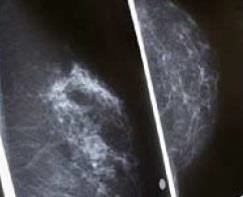Complicated Breast Cancer

Abstract
Introduction
In our case, factors meet in the patient’s previous medical history are her age – 79 years old – history of hypertension and the fact that she underwent surgery (breast biopsy) for a right breast tumour formation two weeks ago. In the present she is hospitalized in Emergency Surgery Department of the Emergency County Hospital, Timisoara where she is suspected to suffer from mesenteric ischemia.
Conclusions
Early diagnosis is mandatory to obtain healing in breast cancer. An essential role in the early diagnosis of breast cancer is the knowledge of risk factors of this disease and identification of patients who are presenting these risk factors.
Tablet of Contents:
1. Introduction
2. Case presentation
3. Conclusion
1. Introduction
Breast cancer represents one of the serious public health issues, with a particular epidemiological interest both nationally and internationally, remaining one of the most common form of cancer that affect women; its incidence is increasing by approximately 1.7 million new cases each year.
Every year, breast cancer affects nearly 9,000 Romanian women and 3,200 of them are losing the battle with the disease. Breast cancer can be treated if it is found early.
Unfortunately, few women are informed and supported in breast cancer prevention. An ultrasound or a mammogram done on time can make the difference between life and death.
An exact cause of the occurrence of this type of cancer remains unknown [1-3].
Breast cancer can develop in years. Early stages do not cause symptoms. In case of early detection, there is a 5-year survival rate of about 97%. A cancer discovered through mammography or other methods in the early stages is more likely to be treated successfully.
The best strategy for early detection of breast cancer is annual clinical breast examination performed by a doctor on every medical consultation or hospitalization, and monthly breast self-examination. This triple combination is the best method for early detection of breast cancer. Improving the technical method to detect breast cancer through mammography has created another problem. Mammography, even if is considered to a performant method can operate with some criteria of malignancy. There are cases where the features of benign and malignant masses can be similar and some abnormalities that appear benign may be malignant or vice versa. The only diagnostic method which is accurate 100% remains the anatomopathological examination [4-6].
The causes of breast cancer are not fully understood. This means that it is difficult to say why a woman may develop breast cancer and another does not. Certain aspects, known as risk factors may change the likelihood that someone might develop breast cancer. There are certain factors on which we cannot do anything, and other factors that can be changed. Studies show that older age and female hormones play an important role in causing this cancer. The risk of developing breast cancer increases with age [7-9]. Breast cancer is more common among women over 50 who have passed menopause. 8 out of 10 breast cancer cases occur in women over 50 years. Women aged 50 to 70 years, should perform regular screening clinical breast examination.
In our case, factors meet in the patient’s previous medical history are her age – 79 years old – history of hypertension and the fact that she underwent surgery (breast biopsy) for a right breast tumour formation two weeks ago. In the present she is hospitalized in Emergency
Surgery Department of the Emergency County Hospital, Timisoara where she is suspected to suffer from mesenteric ischemia.
Mesenteric ischemia is a very serious condition representing along with acute pancreatitis the syndrome of acute abdomen. This condition is due to the vascular damage of the intestinal wall which may induce septic shock state. Unfortunately, symptoms are poor, and treatment options are limited because of late diagnosis. In this context mortality is in over 70% of the cases.
2. Case presentation
Patient J.A.S., aged 79 years, rural woman, smoker (by the age of 16), was hospitalized in County Emergency Timisoara presenting severe, acute diffuse abdominal pain, the absence of bowel movements. After clinical examination. it raises suspicion of mesenteric ischemia that was later confirmed by performing a computed tomography angiography of the abdomen and pelvis. The result was: mesenteric ischemia, bilateral pleural effusions, proliferative mammary gland lesions on the right breast, axillary lymph nodes on the right side, multiple hydroaeric levels. A history physiological reported the occurrence of menarche by age of 11, with normal menstrual cycles, but also with dysmenorrhea. She had 5 pregnancies, 4 of them being abortions during the first trimester with no known cause at that time; she had one vaginal birth when the baby had reached full term (when she was 26 years), as the patient said; a small fetus weighing 2600gr, Apgar score at birth – 6. The patient took antihypertensive treatment during pregnancy – she does not remember what kind of medication. The vaginal birth, in this case, remains questionable according to the new guidelines and protocols in force [10].
Today there are numerous studies that come to elucidate hematologic pathology, suspected thrombophilia or other blood clotting disorders, and indicate effective treatment for women in order to have a favourable pregnancy outcome [11-19].
Pregnancy that is not monitored by the family doctor and obstetrician is a contributing factor in causing premature birth or birth of new-borns babies who are term and have a low birth weight. Pregnancy-induced hypertension or pre-existing hypertension may endanger the mother’s health, the fetus’s health. These complications may occur during pregnancy or after birth, with adverse effects on fetal development; if we add smoking to all of this risk factors, the risk of complications in the fetus grows [20-24].
Pathological personal history:
- hypertension in pregnancy that sometimes might require treatment.
- patient is complaining of symptoms of stress urinary incontinence. Even if she was diagnosed with stress urinary incontinence, she did not treat surgically as would have been necessary. Stress urinary incontinence is often associated with physical efforts [25, 26].
- On examination there were found presence of bilateral varicose veins in the lower extremities whose treatment should be performed by a surgery specialist [27-29].
Patient investigated ambulatory for tumour formation has the following laboratory data: mammography suggesting malignancy formation, so that a core needle biopsy is performed after 2 weeks.

The EHP result: invasive breast carcinoma, NRC, poorly differentiated (G3, Nottingham score=8, forming glands=3; nuclear pleomorphism=3, mitotic activity=2; approx. 11 mitoses/10HPF of 0.5 mm) lesions associated with high-grade ductal carcinoma in situ:
1. estrogen receptors 80%
2. progesterone receptors 40%
3. Ki-67 40%
4. Her2 0 (negative)
After the patient signed the informed consent, there was performed a surgical laparotomy Intraoperative, there were found bacterial translocation and spontaneous bacterial peritonitis, necrosis of the small bowel, the appearance of a faded leaf, lesions from the angle duodenojejunal up to the hepatic angle of the colon, stomach, pale duodenal mucosa. Due to major expansion of intestinal necrosis – small intestine and the entire right half of the colon (superior mesenteric artery occlusion) it decides that is an outdated medical case in terms of surgical therapeutic resources. Unfortunately, the patient’s condition deteriorates progressively, and had a postoperative cardiorespiratory arrest and died after 5 days from the surgery.
3. Conclusion
Breast cancer is considered a heterogeneous disease, meaning that manifests differently from woman to woman, depending on woman’s age and social class.
Unfortunately, as in the case presented above, approximately 80% of breast cancer are detected at advanced stage when survival rates are lower than at earlier stages. The main factor in late diagnosis of this disease is the lack of prevention and limited access to information.
Early diagnosis is mandatory to obtain healing in breast cancer. An essential role in the early diagnosis of breast cancer is the knowledge of risk factors of this disease and identification of patients who are presenting these risk factors.
The Authors:
PIRVU Alexandru Catalin [1]
BALASAN Cristina [2]
FOGARASSY Attila [2]
PANTEA Stelian [3]
POP Elena [4]
STOIAN Dana [5]
1 “Victor Babes” University of Medicine and Pharmacy, Department X, Emergency surgery, Timisoara, (ROMANIA).
2 “Victor Babes” University of Medicine and Pharmacy, Department XII, Discipline of Obstetrics and Gynaecology, Timisoara, (ROMANIA).
3 “Victor Babes” University of Medicine and Pharmacy Surgery Department, Timisoara, (ROMANIA).
4 “Victor Babes” University of Medicine and Pharmacy, Department of Anatomy and Embryology, Timisoara, (ROMANIA).
5 “Victor Babes” University of Medicine and Pharmacy, Endocrinology Discipline, Timisoara, (ROMANIA).
Contributo selezionato da Filodiritto tra quelli pubblicati nei Proceedings “4th Congress of the Romanian Society for Minimal Invasive Surgery in Ginecology – Annual Days of the National Institute for Mother and Child Health Alessandrescu-Rusescu - 2018”
Per acquistare i Proceedings clicca qui.
Contribution selected by Filodiritto among those published in the Proceedings “4th Congress of the Romanian Society for Minimal Invasive Surgery in Ginecology – Annual Days of the National Institute for Mother and Child Health Alessandrescu-Rusescu - 2018”
To buy the Proceedings click here.



